For those not familiar with porcelain threadless, there have been 23
different U-numbers assigned. (But it has been discovered that the U-978 is in
fact threaded.) This doesn't mean that other styles don't exist, but if there
are other styles, they have not been reported. Added to the pin type porcelain
threadless is the porcelain block insulator, which dates back, at least, to
1848.
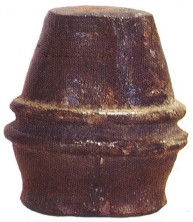
U-970 The porcelain "Egg" was used extensively by the Confederate
Army during the Civil War. This is not to say that it was not manufactured many
years prior to the war. The "eggs" could have been made by a number of
small pottery works, such as Parr's Pottery Works in Richmond, VA. No doubt,
this style was made through the 1850's and 1860's.

Three different glazes on U-970 "eggs"
dark brown almost black,
medium brown and gray.
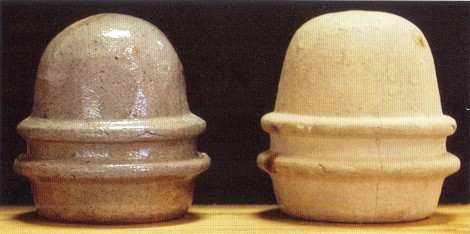
U-971 This rare piece is from Bennington Pottery in Bennington, VT. It has
three short petticoats, in the same fashion as the U-979 and U-980 Elliott
styles. There are four of these beauties known to exist. The one on the right
has no glaze. They were purchased as a group at a Massachusetts flea market in
the early 1990's.
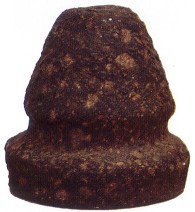
U-972 Elton Gish called this an "overcooked brown"; "the
ugliest and most crude glaze that I have ever seen." I first saw this piece
in a display at the Berea, OH National in 1976. I have not been very successful
in filling in any background on this most unusual piece, evidently, the only
known example.

U-973 This has to be a variant of the U-970. It also has its roots in the
South and might have been a piece used by the Confederate Army, although that is
only an assumption. To date, this is the only U-973 known to exist.

U-974 This "Hat" style seems to have had its roots in the
Northeast. One was dug near Rome, NY in the early 1970's. I know of a second
that was purchased in a Connecticut antique shop about ten years ago. The style
was very popular, yet the number of porcelain "Hats" that have
surfaced are few.

U-975 These two examples have identical features to the U-974, but the
size of the U-975 is somewhat smaller. Five of these were found in Guelph,
Ontario in 1982. One would have to believe that they are of Canadian origin.
Recently, another specimen surfaced in the area of Syracuse, NY.
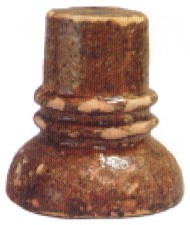
U-975A This U-975A was dug in a Union Civil War camp along the Southeastern
coast of Texas near the Mexican border along the Rio Grande River. The camp is
believed to have been occupied by the 13th Corps. It was dug in 1998.

U-976 This is the smallest of all of the porcelain threadless! This
"Hat" measures barely 2-1/2" tall and was dug in Pennsylvania.
This is a "one of a kind".

U-977 This is another "Hat" style. It is extremely rare. The white
glaze is similar to the U-985, U-986 and U-987, which were all found in the Ohio
area.

U-979 Gerald Brown likened this Elliott type to a fog bowl shape. I think it
is closer to the shape of the CD 151. A truly rare Bennington product, I know of
only four.

U-980 This is the "Horned Elliott", a very popular threadless,
dating to the early 1850's. The white flint insulator was invented by E.B.
Elliott. This is another Bennington Pottery product.
Gleason's Pictorial Drawing-Room Companion
October 22, 1853 Issue
With the discovery of this article, over thirty years ago, came
the tie between the Bennington (VT) Pottery Company and the insulator industry.
The article detailed an elaborate exhibition of Bennington Pottery's ware at the
Crystal Palace in New York City in 1853. Clearly shown in the woodcut are the
U-979, U-980 and U-981. (Top pedestal on left surrounding base of urn.)
Quoted from the article: "Telegraph insulators, in white
flint, are on exhibition. This ware has been employed on the telegraphs in the
vicinity of Boston: among these specimens is a patented form, recommended by Mr.
Bachelder, which has a shoulder with a re-entering angle of forty-five degrees;
this angle causes the wind and rain to pass downward and prevents the inside of
the insulator from being wet."


U-981 This is the "Elliott Hat". It is another white flint piece
from Bennington. Its insulating properties were equal to glass and superior in
strength. George Prescott, author of the 1864 "History, Theory &
Practice of the Electric Telegraph" writes of the Elliott white flint
insulator: "Although it is not a perfect insulator, it approaches nearer
the requirements of such than any other which has been tried."

U-982 Jack Tod wrote this about the U-982, "I guarantee, you will enter
a state of euphoria if you ever hold this beautiful and unique specimen in your hands." The Rockingham glaze of the
Bennington Pottery Works make this piece and the U-983 the centerpiece of my
collection.

U-983 This hybrid has most of the general style of the U-982, except that it
has a 12- paneled skirt and a dome that is very similar to the U-979. There are
probably only three known.

U-984 This is one of two known specimens. It was supposedly found in Mobile
Bay in Alabama. It was definitely used by the Confederacy. This piece bears
resemblance to the CD 127.4 Western Union style glass threaded insulator, even
though the threadless preceded the glass piece by many years.
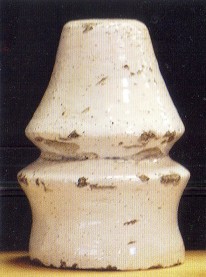
U-985 This is the piece that is shown in Gerald Brown's 1974 book on
porcelain insulators. I know of no other examples, although one would think that
because of its great similarity to the popular CD 731 style, many more would be
found. This piece was reportedly found in the area around Pittsburg, Ohio.
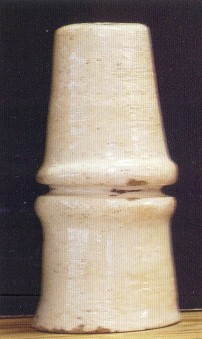
U-986 This is the "Slim Jim"! It surfaced in 1973 in Ohio and, to
date, remains a one of a kind. It has a white glaze with specs of black showing
through. It seems to have many of the characteristics of the U-985. There could
be a tie between them because of the geographic background of each piece.

U-987 The unique peak top and bright white glaze make this "one of a
kind" piece stand out. This insulator was originally found in the Ohio
area. The crackled glaze has similarities to the other porcelain threadless styles attributed to the
area.

U-988 This is the "Slash Top"! These unique white-glazed beauties
were said to have been used on Confederate telegraph lines during the Civil War. The U-988's surfaced in 1975 in Georgia! There were approximately
25 located and they quickly found their way into collections. There is an
excellent article about the "Slash Tops" in the February, 1976 issue
of Crown Jewels of the Wire magazine.

U-989 This unusual piece was also found in the Mobile, Alabama area. It is
thought to be another style of insulator used by the Confederacy during the
Civil War. A closer examination of a fairly elaborate key-lock design in the
pinhole would cast some doubt about this being a war-time product, except for
the fact that examples of the U-989 were found at the Southern Porcelain Co. in
Kaolin, Sc. Southern Porcelain was a major supplier of insulators to the
Confederacy.

U-990 These are the "Teapots"! Gerald Brown wrote: "this
insulator seems to me, to be the most interesting and among the rarest of all
the porcelains that have been found." Although not the rarest anymore, it
is still the most interesting. I have several, of which no two come close to
another in color. There are two sizes: the larger is 4-3/8" diameter and
the smaller is 3-7/8".

Jack Tod referenced the following to the 1939 book "Marketing Burned
Clay Products", by A. Hamilton Chute: "A pottery in Kaolin, SC during
the war, made porcelain and pottery insulators for use on the Confederate
Telegraph Line." Jack then mused that "some of you insulator buffs
should try out the dump digging in Kaolin. Wow, just the thought of finding that one!" That
was in 1975.

In the February, 1997 issue of Crown Jewels of the Wire magazine, Dick Bowman
proclaimed, "It is a mystery no more!"

The Southern Porcelain dump had been located and dug. The unglazed U-990
"Teapot" and porcelain block and examples of the specimens dug at the
recently discovered site. The U-989 has also been linked to the Southern
dig.
The Southern Porcelain Co. was founded in 1856 by William Farrar, who also
had ties to the U.S. Pottery in Bennington, VT, another known producer of
porcelain threadless. Southern made insulators for the Confederacy at least for
the duration of the Civil War era. A fire consumed the factory in 1864, but a
new porcelain company was organized in 1865.
One can only speculate about the
years prior to and just after the Civil War. What was Southern Porcelain's
involvement in the insulator business then?

U-1960 There are the only three known examples of the U-1960 in the hobby at
this time. Although the shape is similar to other porcelain "Hats",
the unusually large 1-5/8" diameter pinhole makes this Canadian piece unique
to all other porcelain threadless.
Displayed for the first time together at the
2000 national were the three known U-1960 "Hendersons", a most unique
threadless "hat".
Reference is made in "The Telegraph in America", when giving an
account of the Peoples Telegraph, "The insulators, instead of being made of
glass, were of glazed earthenware, imperfectly vitrified, through the thin crust
of which the wire soon sawed its way, and left the soft pottery exposed to the
rain, which soon soaked into the mass." Peoples Telegraph ran from
Louisville, KY to New Orleans, LA. Pictured here is a porcelain block
manufactured for the Placerville and Humbolt Telegraph Company by the Pacific
Pottery Company in Sacramento, California.

U-978 The U-978 (not pictured) mistakenly made its way into the threadless
category. In fact, the only two examples of this style of insulator have been in
the Smithsonian Institution's National Museum of American History since 1904.
They have been photographed, measured, carefully examined and clearly are
threaded insulators. In time, the U-978 should be eliminated from the list of
threadless porcelain insulators.

These three blocks are believed to have been used on the Peoples Telegraph
line.

THREADLESS PORCELAIN at the 2000 NIA Convention, Minneapolis, Minnesota
Dr.
Fredrick L. Griffin Memorial Award for Best Use of Threadless
Best Exhibit using
Eastern Insulators


































































